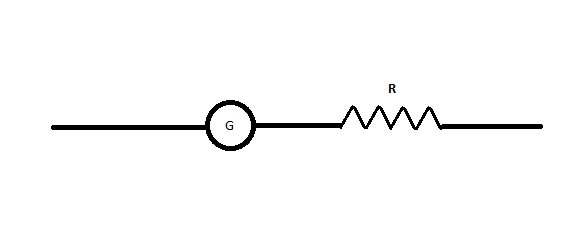
Answer
438k+ views
Hint: First let us understand for what purpose galvanometer and voltmeter are used. A Galvanometer is used to detect the amount of current flowing in the circuit. While the voltmeter is used to measure the potential difference between two points in a circuit. The galvanometer is used as a voltmeter by connecting the high resistance in series with the circuit.
Complete solution:
The galvanometer works on the principle of a torque experienced by a current sustaining coil kept in a fixed magnetic field. The main principle of the voltmeter is that it must be connected in parallel in which we want to measure the voltage. Parallel connection is used because a voltmeter is constructed in such a way that it has a very high value of resistance. So, if that high resistance is connected in series then the current flow will be almost zero which means the circuit has become open.
Consider the following diagram.

In the above diagram, a resistor is connected in series with the galvanometer in the circuit. Let $G$ be the resistance of the galvanometer and ${I_G}$ the maximum deflection in the galvanometer. To measure the maximum voltage \[V\] by the voltmeter, the high resistance $R$ is connected in series. Therefore,
$\therefore V = {I_G}(R + G)$
$ \Rightarrow {I_G}R = V - {I_G}G$
$ \Rightarrow R = \dfrac{V}{{{I_G}}} - G$
This equation gives the value of resistance $R$ which is connected in series to the galvanometer, is converted into a voltmeter of range 0 – V volts. The effective resistance of the voltmeter ${R_V} = R + G$ .
Since the resistor $R$ is high, the resistance of the voltmeter ${R_V}$ is high and it will not draw much current from the circuit.
Note: The resistor of very high resistance in the circuit should be connected in series not in a parallel manner. If the resistor is connected in a parallel manner then there will be no effect on the galvanometer. The very important equation used to calculate the resistance of the resultant voltmeter is Ohm’s law. Ohm's law states that the voltage or potential difference between two points is directly proportional to the current or electricity passing through the resistance, and directly proportional to the resistance of the circuit.
Complete solution:
The galvanometer works on the principle of a torque experienced by a current sustaining coil kept in a fixed magnetic field. The main principle of the voltmeter is that it must be connected in parallel in which we want to measure the voltage. Parallel connection is used because a voltmeter is constructed in such a way that it has a very high value of resistance. So, if that high resistance is connected in series then the current flow will be almost zero which means the circuit has become open.
Consider the following diagram.

In the above diagram, a resistor is connected in series with the galvanometer in the circuit. Let $G$ be the resistance of the galvanometer and ${I_G}$ the maximum deflection in the galvanometer. To measure the maximum voltage \[V\] by the voltmeter, the high resistance $R$ is connected in series. Therefore,
$\therefore V = {I_G}(R + G)$
$ \Rightarrow {I_G}R = V - {I_G}G$
$ \Rightarrow R = \dfrac{V}{{{I_G}}} - G$
This equation gives the value of resistance $R$ which is connected in series to the galvanometer, is converted into a voltmeter of range 0 – V volts. The effective resistance of the voltmeter ${R_V} = R + G$ .
Since the resistor $R$ is high, the resistance of the voltmeter ${R_V}$ is high and it will not draw much current from the circuit.
Note: The resistor of very high resistance in the circuit should be connected in series not in a parallel manner. If the resistor is connected in a parallel manner then there will be no effect on the galvanometer. The very important equation used to calculate the resistance of the resultant voltmeter is Ohm’s law. Ohm's law states that the voltage or potential difference between two points is directly proportional to the current or electricity passing through the resistance, and directly proportional to the resistance of the circuit.
Recently Updated Pages
A very dilute acidic solution of Cd2+ and Ni2+ gives class 12 chem sec 1 JEE_Main

Calculate the equivalent resistance between A and class 12 physics JEE_Main

The potential difference between points A and B in class 12 physics JEE_Main

A wire is bent in the form of a triangle now the equivalent class 12 physics NEET_UG

For the circuit shown in figure the equivalent capacitance class 12 physics JEE_Main

If on applying the potential of 20 V on a conductor class 12 physics JEE_Main

Trending doubts
Which are the Top 10 Largest Countries of the World?

What is the definite integral of zero a constant b class 12 maths CBSE

Differentiate between homogeneous and heterogeneous class 12 chemistry CBSE

Explain sex determination in humans with the help of class 12 biology CBSE

How much time does it take to bleed after eating p class 12 biology CBSE

Distinguish between asexual and sexual reproduction class 12 biology CBSE




